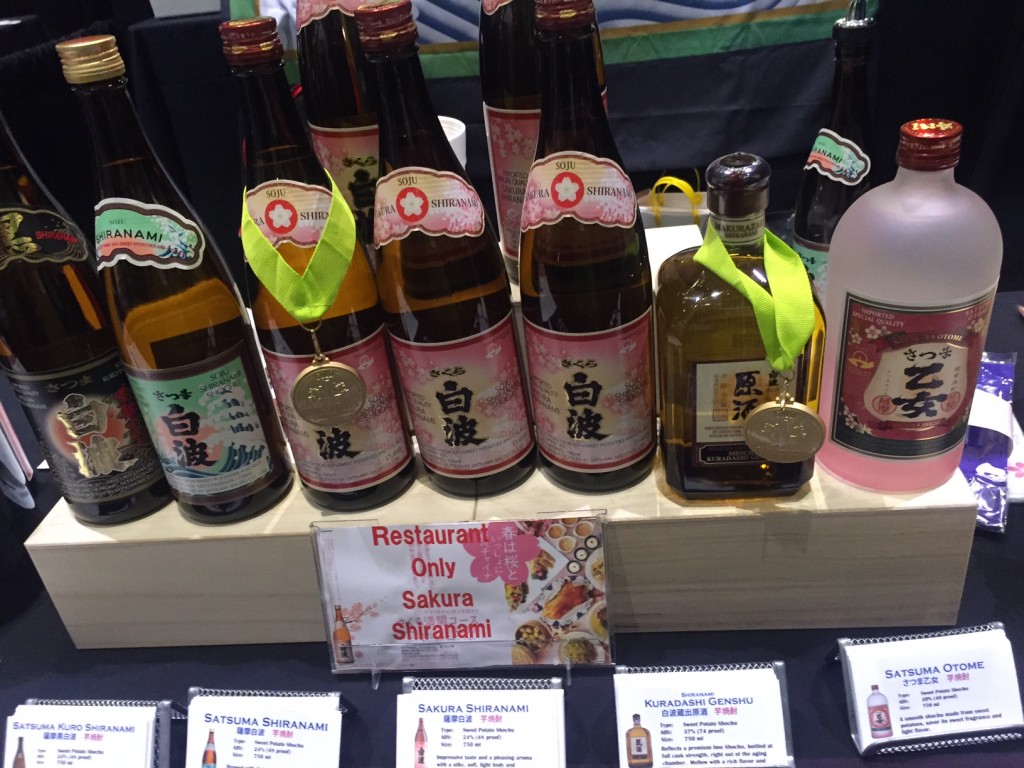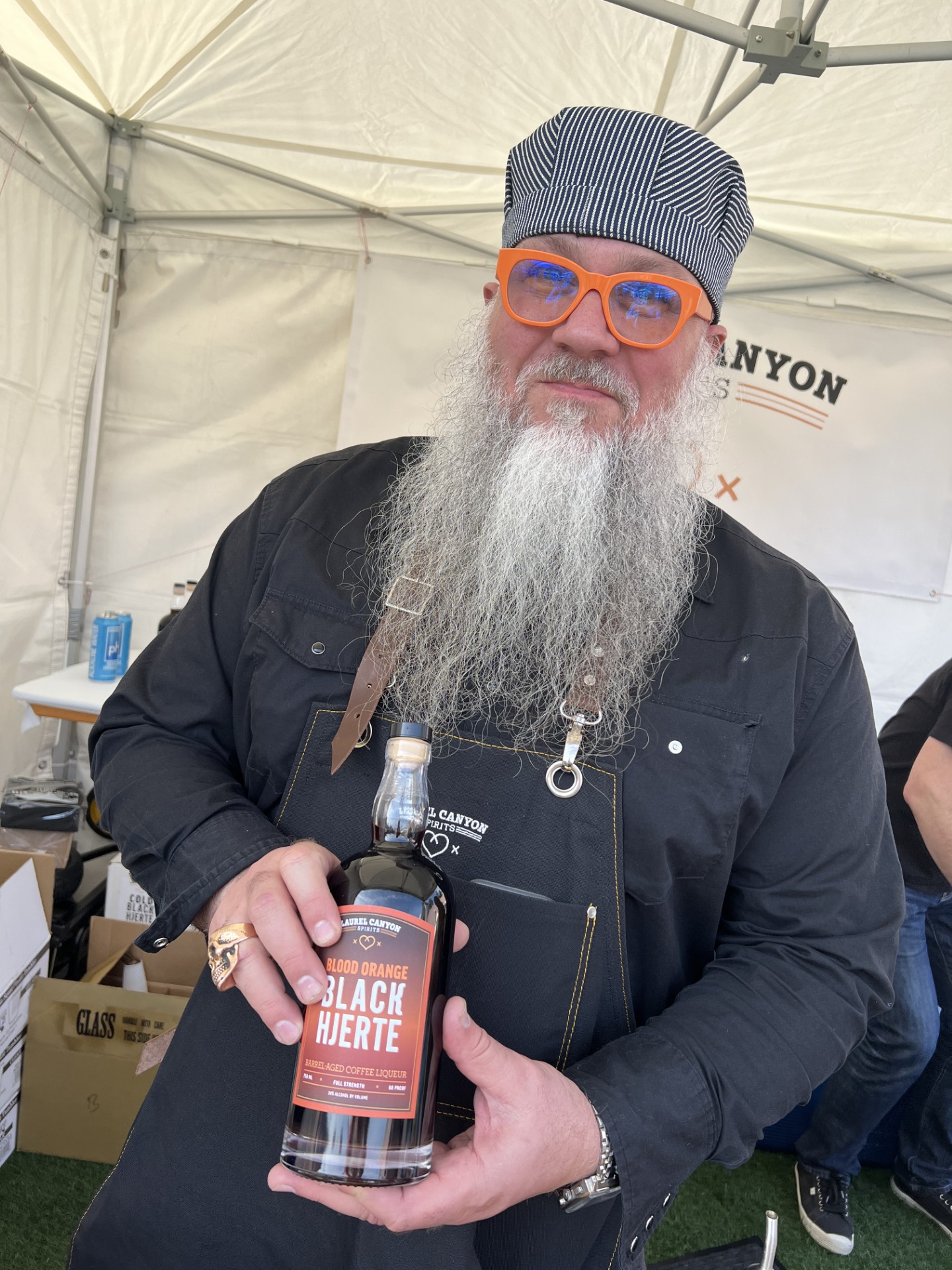Essentially I attended the Japanese Food and Restaurant Expo to cover the sake and shochu portion (read part one of my coverage on the classes I attended on sake and shochu posted 10/13 on this blog) but I also knew, from my previous coverage of food shows, that beverages are only part of the picture.
 In this second part of my coverage I will share both the food and drink that I found particularly tasty.
In this second part of my coverage I will share both the food and drink that I found particularly tasty.
Japanese Foods
These were just some of the delicious Japanese cuisine available for sampling: tuna poke, albacore seared in garlic and other spices, fried shrimp pops, orange chicken, scallops, tempura, green tea, salads with various dressings, ponzu sauce, sesame oil, sesame paste, citrus drinks, a “young peach with syrup” for cocktails and what many Japanese people waited in long lines for: Ramen noodle soup. Everything looked and smelled heavenly.
Shochu and Sake Favorites
Most of the photos I took I compiled into three grids that can be seen here. (My personal favorite is me at a Sapporo refrigeration unit made by Everest.) As there was so much to see and taste there was no way I could possibly give each vendor the attention they deserved.
I also had taken the two classes mentioned above so I only have an hour or two, which I divided between a few sakes (some in expressions I hadn’t tried before) and lots of shochu that was new to me (as many restaurants that only have beer and wine licenses make shochu-based cocktails).
online pharmacy https://www.gcbhllc.org/files/pdf/symbicort.html no prescription drugstore
For my sake and shochu 101ers, this is some general information about the differences between the two, from BoutiqueJapan.com:
While “sake” can be a catch-all term for Japanese alcoholic drinks in general, the sake that most non-Japanese people are familiar with is a type of rice wine. Despite the wine designation, sake’s brewing process is actually closer to that of beer. While there are countless sake varieties with diverse flavors, types can be roughly divided along 2 extremes: “amakuchi” (sweet) and “karakuchi” (bitter/sour). The type of rice and water are both important in determining the flavor. Sake is one of those traditional Japanese drinks that remains popular today despite the influx of other alcoholic imports to Japan.
Shochu is the catch-all name for a wheat-based variety of Japanese alcoholic drinks. Shochu is typically combined with other ingredients (such as sweet potatoes, grown especially in the lava-enriched soil around the volcanoes of Kyushu) or brown sugar (the most famous Okinawan variety) during the distillation process. Although amounts can vary, shochu generally has more alcohol content per serving than sake.
Below are the sake and shochu that I grabbed technical sheets from as they were very delicious, so if you want more info email me:
Satsuma Shiranami sweet potato shochu – also referred to as Imo Shochu; Tenshino Yuwaku “Angel’s Temptation” sweet potato shochu; Kuro Shiranami Imo Shochu; Satsuma Otome Imo Shochu; Kuradashi Genshu (Shiranami Distiller’s Select) Imo Shochu; Kinjo Shiro Barrel Aged Rice Shochu; Choya Japanese Liqueur in Classic (sweet and tart), Shiso (Shiso herb flavor) and Honey (used instead of sugar); nearly everything we tried at the Houraisen table: Bi/Beauty Junmai Dai Ginjo for its “feminine” floral balance, Wa/Harmony Junmai Ginjo and Ghin/Promise Junmai Dai Ginjo was the top of the line and just perfect; from Okinawa and distilled from rice: Shimauta and Hanashimauta; “Umepon” which is a Dekopon Orange “a seedless and very sweet citrus fruit” and Plum liqueur; sweet potato and rice malt in Tomi-no Houzan, Kiccho Houzan and Hakuten Houzan; an incredible line-up of sake from the three-centuries old Katsuyama: Diamond Akatsuki Junmai Daiginjo Enshin-shibori, Akatsuki Junmai Daiginjo Enshin-shibori, Ren Junmai Daiginjo Kake-shibori, Den Junmai Daiginjo Fukuro-shibori, Ken Junmai Ginjo Fukuro-shibori, Gen Genroku shikomi (sweet and rich) and Lei Junmai Ginjo Fukuro-shibori (also sweet and rich) and the lineup from Takasago Shuzo.
About Mutual Trading (From Facebook)
MUTUAL TRADING COMPANY INC. is the premier Japanese food, alcohol beverage, and restaurant supply specialist. We are the Japanese food authority – true to the heart in upholding genuine Japanese cuisine traditions, and progressive in exploring new ways to provide innovative products and services. Mutual Trading imports, exports, distributes and manufactures the top brands for our retailer and foodservice customers.
For the last half century, MUTUAL TRADING has single mindedly followed one corporate mission: “Bringing the Flavors of Japan to the People of the World”.
online pharmacy https://www.gcbhllc.org/files/pdf/levaquin.html no prescription drugstore
Today, we’re seeing a general acceptance and heightened regard for Japanese foods from people in diverse regions across the world. This is truly an exciting time. We express our sincere respect to those who have endeavored to promote Japanese cuisine.
http://lamtc.com/solutions-resources/2017-japanese-food-restaurant-expo/
http://lamtc.com/
https://www.facebook.com/mutualtrading/
https://www.instagram.com/mutual_trading/ @mutual_trading
Eve Bushman has a Level Two Intermediate Certification from the Wine and Spirits Education Trust (WSET), a “certification in first globally-recognized course” as an American Wine Specialist ® from the North American Sommelier Association (NASA), Level 1 Sake Award from WSET, was the subject of a 60-minute Wine Immersion video, authored “Wine Etiquette for Everyone” and has served as a judge for the Long Beach Grand Cru. You can email Eve@EveWine101.com to ask a question about wine or spirits. You can also seek her marketing advice via Eve@EveBushmanConsulting.com









